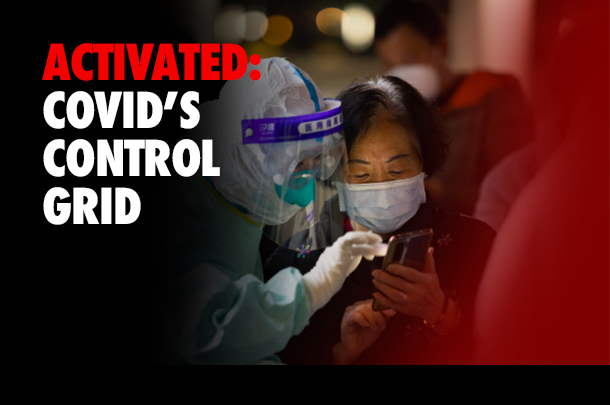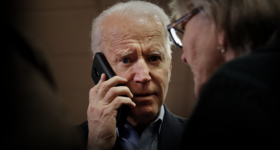“You have been spotted as having participated in acts of violence in the Al-Aqsa Mosque,” it read in Arabic. “We will hold you accountable.”
Ramlawi, then 19, was among hundreds of people who civil rights attorneys estimate got the text last year, at the height of one of the most turbulent recent periods in the Holy Land. Many, including Ramlawi, say they only lived or worked in the neighborhood, and had nothing to do with the unrest. What he didn’t know was that the feared internal security agency, the Shin Bet, was using mass surveillance technology mobilized for coronavirus contact tracing, against Israeli residents and citizens for purposes entirely unrelated to COVID-19.
In the pandemic’s bewildering early days, millions worldwide believed government officials who said they needed confidential data for new tech tools that could help stop coronavirus’ spread. In return, governments got a firehose of individuals’ private health details, photographs that captured their facial measurements and their home addresses
Now, from Beijing to Jerusalem to Hyderabad, India, and Perth, Australia, The Associated Press has found that authorities used these technologies and data to halt travel for activists and ordinary people, harass marginalized communities and link people’s health information to other surveillance and law enforcement tools. In some cases, data was shared with spy agencies. The issue has taken on fresh urgency almost three years into the pandemic as China’s ultra-strict zero-COVID policies recently ignited the sharpest public rebuke of the country’s authoritarian leadership since the pro-democracy protests in Tiananmen Square in 1989.
For more than a year, AP journalists interviewed sources and pored over thousands of documents to trace how technologies marketed to “flatten the curve” were put to other uses. Just as the balance between privacy and national security shifted after the Sept. 11 terrorist attacks, COVID-19 has given officials justification to embed tracking tools in society that have lasted long after lockdowns.
“Any intervention that increases state power to monitor individuals has a long tail and is a ratcheting system,” said John Scott-Railton, a senior researcher at the Toronto-based internet watchdog Citizen Lab. “Once you get it, is very unlikely it will ever go away.”
CODE RED
In China, the last major country in the world to enforce strict COVID-19 lockdowns, citizens have been required to install cell-phone apps to move about freely in most cities. Drawing from telecommunications data and PCR test results, the apps produce individual QR codes that change from green to yellow or red, depending on a person’s health status.
The apps and lockdowns are part of China’s sweeping pandemic prevention policies that have pushed the public to a breaking point. When an apartment fire in Urumqi last month left at least 10 dead, many blamed zero-tolerance COVID policies. That sparked demonstrations in major cities nationwide, the largest display of defiance in decades, after which the government announced it would only check health codes in “special places,” such as schools, hospitals and nursing homes.
Last week, the government went further, saying it would shut down a national-level health code to ease travel between provinces. But cities and provinces have their own codes, which have been more dominant. In Beijing last week, restaurants, offices, hotels and gyms were still requiring local codes for entry.
Over the past few years, Chinese citizens have needed a green code to board domestic flights or trains, and in some cities even to enter the supermarket or to get on a bus. If they were found to have been in close contact with someone who tested positive for COVID-19, or if the government imposed a local quarantine, the code would turn red, and they were stuck at home.
There’s evidence that the health codes have been used to stifle dissent.
__
This story, supported by the Pulitzer Center on Crisis Reporting, is part of an ongoing Associated Press series, “Tracked,” that investigates the power and consequences of decisions driven by algorithms on people’s everyday lives.
__
In early September, former wealth manager Yang Jiahao bought a train ticket to Beijing, where he planned to lodge various complaints with the central government. The night before, a woman he described as a handler invited him to dinner. Handlers are usually hired by state security as part of “stability maintenance” operations and can require people to meet or travel when authorities worry they could cause trouble. Yang had a meal with the handler, and the next morning Guangzhou health authorities reported a COVID-19 case less than a kilometer from where they dined, he said.
Based on city regulations, Yang’s code should have turned yellow, requiring him to take a few COVID tests to show he was negative.
Instead, the app turned red, even though tests showed that he didn’t have COVID. Yang was ordered to quarantine and a paper seal was placed on his door.
“They can do whatever they want,” he said.
From Beijing to Jerusalem to Hyderabad, India, The Associated Press has found that authorities used COVID-19 technologies and data to halt travel for activists and ordinary people, and link people’s health information to other surveillance and law enforcement tools. (AP Video)
An officer at the Huangcun station of the Guangzhou police referred comment to city-level authorities on Yang’s case, saying he required proof that the caller was from AP. Guangzhou’s Public Security Bureau and the city’s Center for Disease Control and Prevention did not respond to faxed requests for comment.
In another show of how the apps can control lives, in June, a group of bank customers were effectively corralled by the health codes when they tried going to Henan’s provincial capital in Zhengzhou to protest being unable to access their online bank accounts.
A notice said the problem was due to a system upgrade. But the customers soon found out the real reason: a police investigation into stockholders in the parent bank had rendered 40 billion yuan in funds inaccessible, according to local media reports. Frustrated after months of complaints, a group of customers decided to hold a protest in Zhengzhou at the provincial banking commission.
Customer Xu Zhihao uploaded his itinerary to get the Henan province health code after he tested negative for COVID-19 in his coastal city of Tianjin, just south of Beijing. As he got off the train in Zhengzhou, Xu was asked to scan his QR code at the station, and immediately it turned red. The train station employee called security and took him to a police booth.
Xu said police took him to the basement to quarantine. Three other people joined him, and all four realized that they had come to get their money back.
“They had set the net in place, waiting for us,” Xu said.
From a group chat, Xu and others learned that many protesters had met a similar fate, at the high-speed rail train station, at the airport and even on the highway. A government inquiry later found that red codes were given to 1,317 people, many of whom had planned to protest.
China’s National Health Commission, which has led the COVID response, did not reply to a fax requesting comment. The Henan provincial government did not respond either.
Even after China ends lockdowns, some dissidents and human rights activists predict the local-level health codes will stay on as a technological means of social control. Early on, provinces didn’t share data, but in the past few years, that has changed.
Some provincial governments have created local apps that can link health, location and even credit information, which leaves open the possibility for these apps or the national databases they draw from to be used to monitor people in the future, according to an AP review of procurement documents, research and interviews. Xu and Yang, for instance, were both stopped in their tracks by local health codes.
In February, police in northeastern Heilongjiang province sought to upgrade their local health code so they could search PCR test results for anyone in China, in real time, according to procurement documents provided exclusively by ChinaFile, a digital magazine published by the Asia Society. A company whose parent is government-owned won the non-competitive bid to connect that app to a national database of PCR data run by the State Council, China’s Cabinet, fulfilling a national directive, the documents show. The same company, Beijing Beiming Digital Technology, also claims on its website that it has developed more than 30 pandemic apps.
“It’s the governance model, the philosophy behind it is to strengthen social control through technology. It’s strengthened by the health app, and it’s definitely going to stay after COVID is over,” said Yaqiu Wang, a senior researcher with Human Rights Watch. “I think it’s very, very powerful.”
“THERE ARE TWO SETS OF LAWS”
In Jerusalem’s Old City, tourists sipping fresh pomegranate juice, worshippers and locals taking a shortcut home are all monitored by Israeli security forces holding automatic weapons. The labyrinth of cavernous pathways is also lined with CCTV cameras and what authorities have described as “advanced technologies.”
After clashes in May 2021 at the Al-Aqsa Mosque helped trigger an 11-day war with Hamas militants in the Gaza Strip, Israel experienced some of the worst violence in years. Police lobbed stun grenades into the disputed compound known to Jews as the Temple Mount, home to Al-Aqsa, Islam’s third-holiest site, as Palestinian crowds holed up inside hurling stones and firebombs at them.
By that time, Israelis had become accustomed to police showing up outside their homes to say they weren’t observing quarantine and knew that Israel’s Shin Bet security agency was repurposing phone surveillance technology it had previously used to monitor militants inside Palestinian territories. The practice made headlines at the start of the pandemic when the Israeli government said it would be deployed for COVID-19 contact tracing.
A year later, the Shin Bet quietly began using the same technology to send threatening messages to Israel’s Arab citizens and residents whom the agency suspected of participating in violent clashes with police. Some of the recipients, however, simply lived or worked in the area, or were mere passers-by.
Ramlawi’s coffeeshop sits in the ornate Cotton Merchant’s Market outside the mosque compound, an area lined with police and security cameras that likely would have identified the barista had he participated in violence.
Although Ramlawi deleted the message and hasn’t received a similar one since, he said the thought of his phone being used as a monitoring tool still haunts him.
“It’s like the government is in your bag,” said Ramlawi, who worries that surveillance enabled to stop COVID-19 poses a lasting menace for east Jerusalem residents. “When you move, the government is with you with this phone”….
Authors GARANCE BURKE, JOSEF FEDERMAN, HUIZHONG WU, KRUTIKA PATHI and ROD McGUIRK
SOURCE: AP
READ MORE COVID NEWS AT: 21st Century Wire COVID Files
ALSO JOIN OUR TELEGRAM CHANNEL
PLEASE HELP SUPPORT OUR INDEPENDENT MEDIA PLATFORM HERE
















